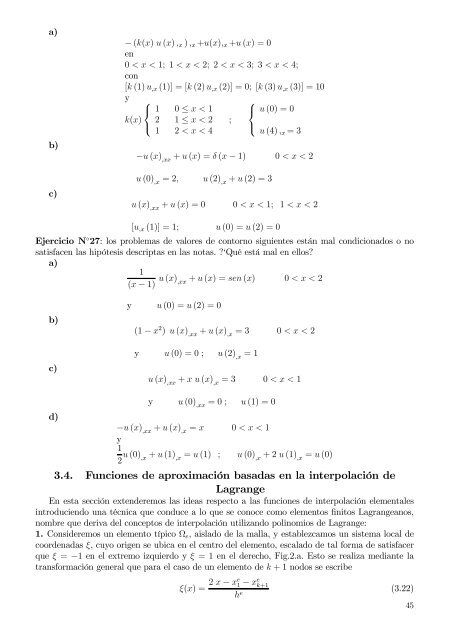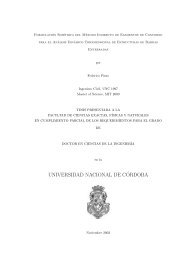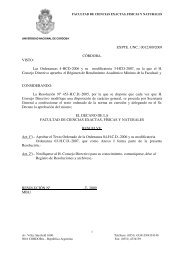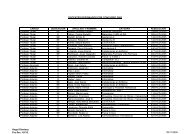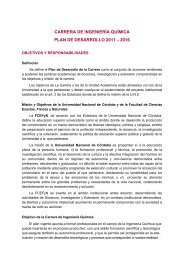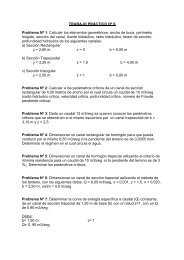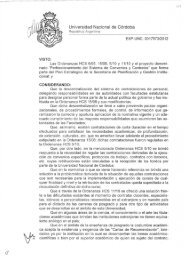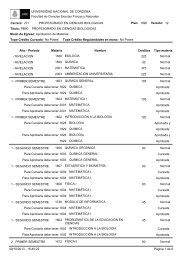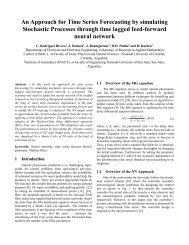Capítulo 1 Métodos de residuos ponderados Funciones de prueba ...
Capítulo 1 Métodos de residuos ponderados Funciones de prueba ...
Capítulo 1 Métodos de residuos ponderados Funciones de prueba ...
You also want an ePaper? Increase the reach of your titles
YUMPU automatically turns print PDFs into web optimized ePapers that Google loves.
a)<br />
b)<br />
c)<br />
− (k(x) u (x) , x ) , x +u(x), x +u (x) = 0<br />
en<br />
0 < x < 1; 1 < x < 2; 2 < x < 3; 3 < x < 4;<br />
con<br />
[k (1) u ,x (1)] = [k (2) u ,x (2)] = 0; [k (3) u ,x (3)] = 10<br />
y<br />
⎧<br />
⎨<br />
k(x)<br />
⎩<br />
1 0 ≤ x < 1<br />
2 1 ≤ x < 2<br />
1 2 < x < 4<br />
;<br />
⎧<br />
⎨<br />
⎩<br />
u (0) = 0<br />
u (4) , x = 3<br />
−u (x) ,xx<br />
+ u (x) = δ (x − 1) 0 < x < 2<br />
u (0) ,x<br />
= 2, u (2) ,x<br />
+ u (2) = 3<br />
u (x) ,xx<br />
+ u (x) = 0 0 < x < 1; 1 < x < 2<br />
[u ,x (1)] = 1; u (0) = u (2) = 0<br />
Ejercicio N ◦ 27: los problemas <strong>de</strong> valores <strong>de</strong> contorno siguientes están mal condicionados o no<br />
satisfacen las hipótesis <strong>de</strong>scriptas en las notas. ?‘Qué está mal en ellos?<br />
a)<br />
1<br />
(x − 1) u (x) ,xx<br />
+ u (x) = sen (x) 0 < x < 2<br />
b)<br />
c)<br />
d)<br />
y u (0) = u (2) = 0<br />
(1 − x 2 ) u (x) ,xx<br />
+ u (x) ,x<br />
= 3 0 < x < 2<br />
y u (0) = 0 ; u (2) ,x<br />
= 1<br />
u (x) ,xx<br />
+ x u (x) ,x<br />
= 3 0 < x < 1<br />
y u (0) ,xx<br />
= 0 ; u (1) = 0<br />
−u (x) ,xx<br />
+ u (x) ,x<br />
= x 0 < x < 1<br />
y<br />
1<br />
2 u (0) ,x + u (1) ,x = u (1) ; u (0) ,x + 2 u (1) ,x = u (0)<br />
3.4. <strong>Funciones</strong> <strong>de</strong> aproximación basadas en la interpolación <strong>de</strong><br />
Lagrange<br />
En esta sección exten<strong>de</strong>remos las i<strong>de</strong>as respecto a las funciones <strong>de</strong> interpolación elementales<br />
introduciendo una técnica que conduce a lo que se conoce como elementos finitos Lagrangeanos,<br />
nombre que <strong>de</strong>riva <strong>de</strong>l conceptos <strong>de</strong> interpolación utilizando polinomios <strong>de</strong> Lagrange:<br />
1. Consi<strong>de</strong>remos un elemento típico Ω e , aislado <strong>de</strong> la malla, y establezcamos un sistema local <strong>de</strong><br />
coor<strong>de</strong>nadas ξ, cuyo origen se ubica en el centro <strong>de</strong>l elemento, escalado <strong>de</strong> tal forma <strong>de</strong> satisfacer<br />
que ξ = −1 en el extremo izquierdo y ξ = 1 en el <strong>de</strong>recho, Fig.2.a. Esto se realiza mediante la<br />
transformación general que para el caso <strong>de</strong> un elemento <strong>de</strong> k + 1 nodos se escribe<br />
ξ(x) = 2 x − xe 1 − x e k+1<br />
h e (3.22)<br />
45


